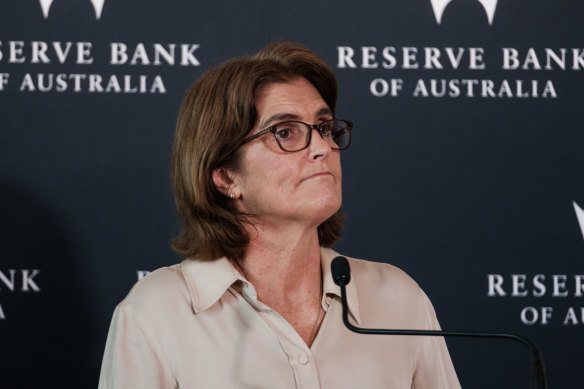This was published 1 year ago
RBA scraps explicit warning on rate rises but inflation war not over yet
By Rachel Clun and Millie Muroi
Interest rates could fall as soon as August after the Reserve Bank dropped its explicit warning that more rate rises might be needed to curb inflation while saying it was not blind to the financial pressures on many Australians.
The Reserve board kept the official cash rate at 4.35 per cent on Tuesday, as expected by economists. But a key change to the statement explaining its decision convinced financial markets to price in a winter rate cut.

RBA governor Michele Bullock said the risks around getting inflation back within the target range remained finely balanced.Credit: Oscar Colman
The board said that while it remained determined to return inflation to its target range of 2-3 per cent by the second half of next year, what that meant for interest rates was not certain.
In February, the board said “a further increase in interest rates cannot be ruled out”, while Tuesday’s statement said “the board is not ruling anything in or out”.
Governor Michele Bullock acknowledged the board had changed its language around the need for more rate rises, as recent data showed the economy remained broadly on track to getting inflation down to its target.
“We’re not confident enough to say we can rule out further interest rate changes, but we do think we are on the path to get ourselves back to inflationary targets within our forecast period,” Bullock said.
“We still have to get inflation down, and the risks to achieving that remain finely balanced. The war is not yet over.”
The RBA board noted that monthly inflation fell to 3.4 per cent in January and that high interest rates were helping to rein in consumer spending. Conditions in the jobs market were continuing to ease and wage growth appeared to have peaked.
Bullock said Tuesday’s announcement by the energy regulator that power bills would fall by as much as 10 per cent would also help the case for cutting interest rates this year.
“Ultimately, I think it will assist,” said Bullock, who noted that energy price rises had been a big driver of inflation, affecting households and businesses.
“An easing in energy prices – even if it is just a stabilisation, it’s not increasing any more – I think that is positive for the inflation outlook and I think that is good news.”
Fair Work’s recent decision to lift aged care workers’ pay by up to 28.5 per cent was a worthy change, she said, but would not have a major impact on the central bank’s forecasts.
Treasurer Jim Chalmers said Tuesday’s decision was proof inflation was moderating.
“This decision is a reflection of the good progress that we’re making as a country in the fight against inflation. It gives us confidence that inflation is moderating in welcome and encouraging ways,” he told parliament.
Financial markets took the bank’s change in language as a confirmation the next interest rate move would be down, fully pricing in a quarter of a percentage point rate cut for August.
Commonwealth Bank’s head of Australian economics, Gareth Aird, said that as inflation remained above target, he still expected the first rate cut in September, but there was now a chance it would be August.
AMP chief economist Shane Oliver said a cut could come as early as June, but he conceded there was a strong chance that sticky services inflation and any increase in spending flowing from the stage 3 tax cuts could delay that relief until August or September.
EY chief economist Cherelle Murphy was less certain about the timing of the first rate cut, noting that the housing and labour markets remained tight.
“A rate cut by the third quarter is far from a done deal in our view. As the [Reserve Bank] governor said, the war is not yet won,” she said.
Since May 2022, borrowers have been hit with 13 official interest rate rises, largely passed on by lenders, as the Reserve fought high inflation. The increases have put up repayments on a $600,000 mortgage by almost $1500 a month and some lenders and major financial institutions have recently noticed more Australians falling behind on their repayments.
Shadow treasurer Angus Taylor said the latest rates decision would be cold comfort for struggling households, and the government was not doing enough to reverse the situation.
“Labor’s failures on workplace relations, energy, housing and tax are driving up the cost of living for all Australians. This is a government at war with aspirational Australia,” he said.
Cut through the noise of federal politics with news, views and expert analysis. Subscribers can sign up to our weekly Inside Politics newsletter.